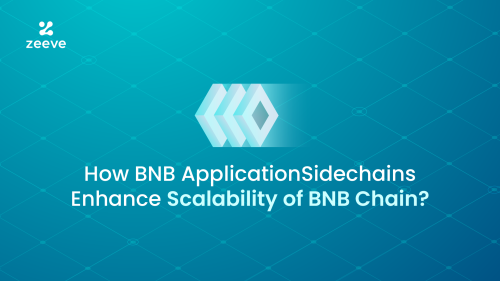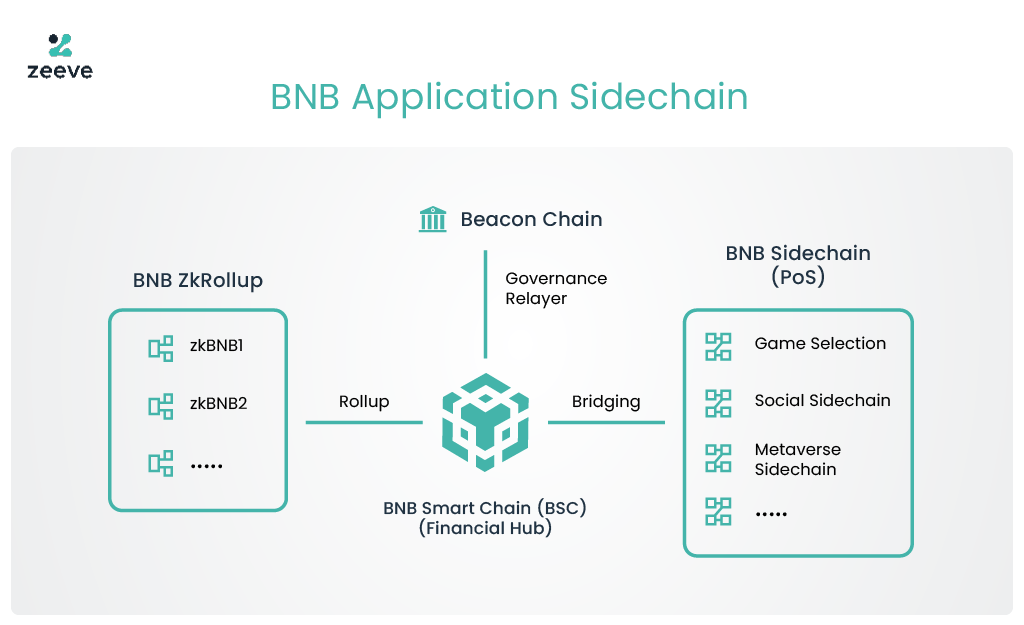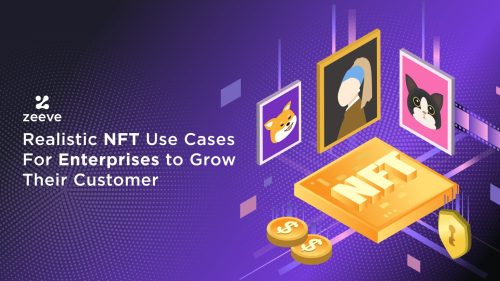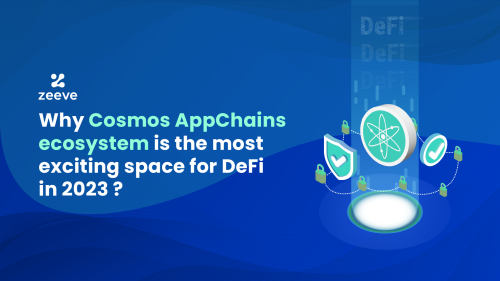
How BNB Application Sidechains Enhance Scalability of BNB Chain?
For years, scalability has been blockchain’s major dilemma, especially for large networks. BNB Chain (formerly known as Binance Smart Chain) as one of the leading blockchain networks, records approximately 2+ million daily active users and 9.8M daily transactions during peak time. This volume is about the present; now, think about the future– this volume can grow tenfold. Such a high volume of users and transactions may slow down any network unless it implements an optimal solution to enhance the overall scalability and security.
Considering this, the BSC community launched BNB application sidechains, also known as BSC sidechains, that provide a full-fledged, highly-performant environment to build application-specific blockchains for managing dApps spanning DeFi, Web3, NFTs, and Gaming. In this connection, let’s decode the concept of BNB application sidechains while understanding the importance of BAS for web3 enterprises, developers, and decentralized projects.
An Overview of BNB Application Sidechains: The app-chain solution of BSC
BNB application sidechains (BAS) is an EVM-compatible, decentralized network infrastructure offered by BSC Smart Chain that allows enterprises and web3 developers worldwide to build their own custom, BNB Smart Chain compatible sidechains (blockchains) to manage a specific dApp. Simply stated, BNB sidechains are a set of customizable smart contracts that supports development of independent blockchains, which are also referred to as application-specific blockchains or AppChains in the Web3 space. Any enterprises looking to scale their dApps can build their own AppChain and tailor it to the specific requirement of the corresponding application. Axie Infinity– a globally-popular NFT marketplace, earlier migrated from the Ethereum ecosystem to its application-specific blockchain, Ronin Chain, which is an independent blockchain with integrated support for ERC-20 tokens to facilitate rewards distribution to the players and staking.
Again, talking about the BNB application sidechains, these are designed to increase the efficiency, security, and scalability of dApps while enabling higher throughput and significantly lower gas fees. BAS deployers enjoy the flexibility to set their own validator rules and custom gas fees, and they can even deploy unique tokens abiding by the BEP121 format. Hence, we can say that BNB application sidechains are not bound by the BNB chain’s inherent rules. BNB sidechains run alongside the BSC’s Governance Relayer— Beacon Chain while fully connecting with the main chain. The main purpose of the BNB Sidechain is to allow any project developer to deploy their blockchain with highly-performant, customized specifications and validator sets while still enabling a connection to the BNB Smart Chain infrastructure.

A BNB sidechain network can run with fewer validators than BNB Chain, depending on the BNB Sidechain deployer and their desired level of security. However, regarding this validator setup, a collective decision is needed, both from the dApp owner and the community stakeholders. Developers and teams can create blockchains with their own business rules and economies. Ultimately, BNB Chain can expand the ecosystem with this modular design and flexibility of sidechains. Popular GameFi platforms like Meta Apes and CUBE have already joined the BAS ecosystem to provide users with better gaming experience.
Why should you use BAS?
BAS has been introduced to eliminate the scalability issues in the blockchain that usually cause network congestion, lower throughput, and slow response time, thereby allowing web3 projects to add further and manage the next billions of users. Any dApp typically recording over 1Million daily active users may suffer network stability and slow transaction processing. Hence, as a multichain solution, BAS enables large-scale applications to run their own blockchain to scale large dApp projects .Decentralized applications when grow tremendously, a need for a more efficient scaling solution arises, and that’s where BNB Application Sidechain helps. Opposed to what happens in traditional blockchains, the increasing network load on BNB sidechains does not affect the performance of dApps; thereby, scalability always remains high.
The BNB Application chain aims to tackle the hassle enterprises face when they have to fork a specific blockchain to build a separate chain. As we know, the fork approach requires heavy programming-related tasks that lead to many potential errors and create the risk of copying projects. With BNB sidechains, enterprises get a whole new infrastructure to build their network from scratch using existing modules that are fully customizable. Additionally, BNB applications sidechains offer high TPS, ultra-low gas fees, and full compatibility with the Ethereum virtual machine. And since BAS is a part of BSC’s largest ecosystem, these Sidechains can leverage the liquidity and user base from the main BNB smart chain.
Ways to build BNB Application Sidechains?
Following are the two most viable options that enterprises and web3 developers can use to build their BNB application sidechains:
Proof-of-Stake Sidechains
The initial version of BAS allowed for the deployment of PoS Sidechains that run parallel to the main blockchain (BSC), but they have seamless connectivity with the mainnet through a two-way bridge. BEP100 put this proposal for these sidechains to connect to BSC by a native relayer hub, so that overall improvement can be done in the performance of the network and higher throughput and lower gas fees can be facilitated. However, with a relayer, the security of the native relayer hub has to be guaranteed by the sidechains. Therefore, validators on BNB Application sidechains must be verified as Relayer to relay, mint, and burn tokens or their native assets on the BNB Smart Chain. While the cross-chain bridge is great for inter-sidechain transfer of data, tokens, NFTs, and other digital assets—it can also cause security-related risks as bridging solutions are considered to be easy entry points for hackers and attackers who can put the network down, steal funds, and access sensitive data available on-chain. As an alternative, BNB Chain extended sidechain support to zkRollups.
Layer-2 zkBNB Rollups
zkBNB represents the next version of the BNB Application Sidechain to tackle the potential security issues causing due to bridging solutions while improving Sidechains’ scalability. ZkRollups is a Layer-2 Ethereum scaling solution that performs all the computations and state changes off-chain. However, a complete summary or cryptographic proof of all these computations is sent securely to the mainnet. Built as zkBNB, BNB Application Sidechains leverages a high-performance scaling and secure architecture and the capability to process (bundle or roll-up) hundreds of transactions as a Rollup Block off-chain. zkBNB can further implement a lot of features powered by zkRollups, such as L1-level security, cross-chain interoperability– between BSC and zkBNB, built-in Automated Market Maker (AMM) and NFT marketplaces, fast finality, up to 10X lower gas fees, and much more.
Want to learn in-depth details about zkRollup? Need to discover Zero Knowledge Solutions use cases? Watch our webinar dedicated to zkRollups: Rolling with Rollups Exploring Optimistic & Zero Knowledge Solutions use cases and Impact
What features does the BNB application sidechain offer?
BNB application sidechain offers a bundle of revolutionary features to enhance the scalability and performance of traditional blockchains. The following are the main benefits BAS offers:
Unbounded scalability and sustainability
‘Scalability’ is the topmost inspiration behind BNB Chain’s launch of BNB application sidechains. As discussed, BNB Sidechains allow any dApp to have their single-use blockchain with custom features, gas tokens, and powerful features, scaling up to billions of users without sacrificing security. With high throughput projected to 5000+ and near-zero gas fees, BAS ensures sustainable growth of blockchain projects while enhancing the overall user experience and performance.
Battle-tested security
BNB application sidechains are closely connected to BNB smart chain, which adopts PoS (Proof-of-Stake) and PoA (Proof-of-Authority) consensus mechanism– complete with advanced algorithms to offer battle-tested security on all the BAS and BNB chains. Any projects that own a BNB Sidechain are, by default, become a part of the BSC ecosystem, and are able to leverage its battle-tested security seamlessly.
Built-in and customizable modules
As independent blockchains, BNB application chains offer ready-to-use modules such as runtime logic, consensus mechanism, genesis, validator specifications, throughput, gas fee, tokens, and wallets. These pre-built modules are designed to make the development of a blockchain network easier while saving considerable time and effort required to build modules from scratch. Depending on the project-specific requirements, you can customize these modules whenever required. Also, developers can use ready-made API gateways, SDKs, governance interfaces, and more.
Full Ethereum-compatibility
Both the version of BNB Sidechain— zkBNB and PoS BNB Sidechains are Ethereum-compatible. This means that BAS can use Ethereum smart contracts, virtual machines, ecosystem components, and tools like Geth, Truffle, and Remix IDE to develop custom smart contracts and dApps.
Custom virtual machine
BNB application sidechains support customizable virtual machines, a feature that allows developers to easily program a custom VM to implement certain functionalities and operations in their independent blockchains. For example, you can allow nodes to execute specific commands or allow for the creation of new tokens.
Cross-blockchain interoperability
A BNB application sidechain can interoperate with the BNB main chain (BSC) and the rest of the sidechains through trustless bridges and Rollups. Also, bridges allow BNB Sidechains to connect with blockchain networks outside the BNB Smart chain ecosystem: Ethereum, Polygon, and BNB Chains.
Plan your BNB Application Sidechain with Zeeve
Zeeve offers services for all kinds of AppChains, be it BNB Application Sidechain, Polkadot Parachain, Polygon Supernets, or Avalanche Subnets. If you are planning to launch your BNB application sidechain from scratch or any complex AppChain project, web3 experts at Zeeve will help you get started with our custom support or on-demand Appchain services. For more information on our AppChain-related services, schedule a one-to-one call with our consultants or become a part of our community discussion on LinkedIn and Telegram.








Responses